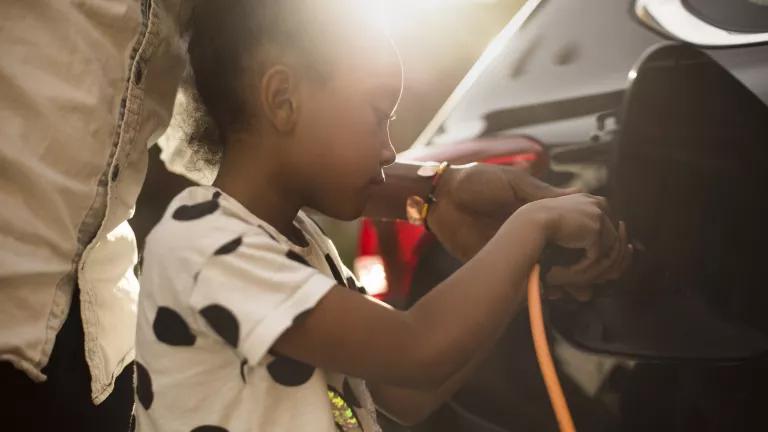Clean Cars Can Bring Over $145 Billion in Benefits to New York
A new study shows that the Advanced Clean Cars rule can bring over $145 billion in benefits to New York.

This blog has been co-authored by Alison Kirsch from the Sierra Club.
Just a few days before the 2023 Times Square Ball Drop, New York State adopted through emergency rulemaking the Advanced Clean Cars II (ACC II) rule, an important set of regulations that will get the ball rolling on rapid deployment of zero-emission light-duty vehicles (LDVs) in the state. It requires manufacturers to sell increasingly higher percentages of new zero-emission vehicles (ZEVs) in each model year (MY), starting at 35 percent ZEV sales in MY 2026 and reaching 100 percent ZEV sales in MY 2035. In this case, ZEVs include battery electric vehicles, plug-in hybrid electric vehicles, and fuel cell electric vehicles.
Thanks to Section 177 of the Federal Clean Air Act, New York is able to implement more stringent-than-federal standards that were originally adopted by California, such as ACC II. Commissioned by the Sierra Club and the Natural Resources Defense Council (NRDC), new analysis from ERM aggregates the potential public health, environmental, and economic impacts of ACC II in New York under different scenarios. This blog will highlight some of the key findings from the analysis.
Policy Scenarios
The report evaluated the following scenarios:
- ACC II Flex: New York adopts ACC II, and vehicle manufacturers use many of the available compliance flexibilities such that they sell fewer ZEVs than is nominally required by the regulation.
- ACC II Flex + Clean Grid: New York adopts ACC II and reaches 100 percent clean electricity generation by 2035. Manufacturers use many of the available compliance flexibilities.
- ACC II Full + Clean Grid: New York adopts ACC II and reaches 100 percent clean electricity generation by 2035. Manufacturers do not use any of the compliance flexibilities.
- Business-as-usual (BAU): All new LDVs sold in New York continue to meet existing vehicle standards. ZEV sales increase but are capped at one-third of new vehicle sales each year.
Public Health and the Environment
Compared to the BAU scenario, by 2050 the ACC II scenarios are expected to reduce annual LDV fleet particulate matter (PM) and nitrogen oxides (NOx) emissions by 92-93 percent. The resulting cumulative public health benefits from 2022 to 2050 would include 447 to 501 fewer premature deaths, 433 to 485 fewer hospital visits, and 279,623 to 314,497 fewer minor cases of illness. The monetized values of these public health benefits total $5.45 billion to $6.11 billion. The ACC II scenarios are also estimated to realize a 95 percent reduction by 2050 in greenhouse gas (GHG) emissions from New York’s LDV fleet, relative to the BAU scenario. The monetized values of the projected cumulative GHG emission reductions are $21 billion to $24 billion.
Economic Impacts
Compared to a gasoline vehicle, the average light-duty ZEV in New York is expected to save its owner $9,200 to $12,000 in fuel and maintenance costs over its lifetime. In MY 2026, although the average light-duty ZEV will be $3,200 more expensive than a gasoline vehicle, the fuel and maintenance savings will help realize almost $9,000 in lifetime savings. From MY 2030 on, the average light-duty ZEV will be cheaper than a gasoline vehicle, so the lifetime savings will amount to up to $13,300. For rural New Yorkers, who are assumed to drive about 62 percent more than the national average, driving a MY 2026 ZEV will cost $1,500 more over its lifetime than driving a gasoline vehicle, but for a MY 2030 ZEV, lifetime costs become $10,500 lower. Drivers of ZEVs purchased after MY 2030 will enjoy total savings of almost $15,000. Overall, ZEV owners can cumulatively save $83 billion to $86 billion by 2050.
Since ACC II will likely increase utility net revenue as it electrifies New York’s LDV fleet, New York’s average residential and commercial rates could be 5.7 percent lower by 2050. The average New York household could therefore save $184 each year on its electricity bill, and the average commercial customer $878 each year.
In addition to electricity bill savings, the deployment of ZEV charging infrastructure will also bring substantial investments. An estimated 26 percent of light-duty ZEVs in New York will need a publicly accessible network of chargers to meet their drivers’ usage patterns, and building that network of chargers can bring $88 million to $92 million of public and private investments to the state each year.
In terms of job benefits, adoption of ACC II will result in a net increase of over 11,700 jobs through 2050. The new jobs are expected to be nearly twice as well-paid as those replaced.
Conclusion
Taken together, the cumulative net societal benefits by 2050 are estimated at $138.4 billion under the ACC II Flex scenario, $139.5 billion under the ACC II Flex + Clean Grid scenario, and $147.1 billion under the ACC II Full + Clean Grid scenario. As such, this analysis demonstrates the significant public health, climate, and economic implications for New York’s transition to a clean transportation system.



